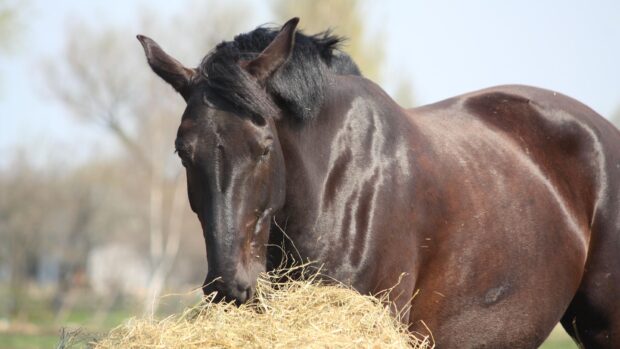Q: I can’t decide whether I should feed my horse hay or haylage this winter.Could you explain the benefits and downsides of each product?
Independent nutritionist Christine Smy replies: Feeding hay or haylage is a personal choice and will depend on budget, local availability and storage space.
Whichever you choose, it should be made from safe and non-toxic grass species. Whether you opt for hay or haylage, try and find out when the grass was cut. Grass should ideally be cut before mid-July, after which its nutritional value begins to decline.
Hay
Pros
Hay cut in late May and June has high feed values and is ideal for performance horses.
Late-cut meadow hay (harvested from late July into August) is ideal for good doers, due to indigestible stalks. The downside is that the horse may get a hay belly.
Cons
Good hay-making weather cannot be guaranteed. Hay needs a hot, dry spell of about four days in order to ‘make’ properly.
Feeding dusty and mouldy hay can lead to respiratory problems. Soaking hay for 20 minutes will wash out or swell any mould spores, reducing coughing.
Incorrect drying can result in the grass leaf shattering and the nutritional goodness being lost. Two-thirds of energy and three-quarters of protein are present in the leaf.
Haylage
Pros
Production is less weather-dependent.
Its high moisture content allows mould to swell and stick to the stalk, which prevents vents horses with respiratory problems.
The smaller haylage bales are easy to store and transport.
Cons
Proprietary brands have their analysis on the bag – something which is often missing on local brands. The higher the moisture content, the lower the fibre, energy and protein levels, so if you know the haylage analysis, you can determine the correct levels to feed. For example, a haylage containing 50 per cent water needs to be fed at a higher quantity than one containing35 per cent water. Most feed companies will analyse haylage for a fee of around £20, or you can contact Direct Laboratories (formerly ADAS), tel: (01902) 693 190.
Problems occur when haylage becomes dry from being left on the ground too long before baling, or where a bale remains opened for too long a period. The spores will shrink and then be inhaled rather than ingested, causing potential lung problems.



